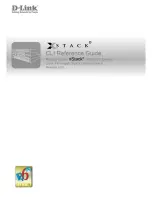
Chapter 7
| Spanning Tree Algorithm
Overview
–
182
–
Figure 100: STP Root Ports and Designated Ports
x
Designated
Bridge
Designated
Root
Once a stable network topology has been established, all bridges listen for Hello
BPDUs (Bridge Protocol Data Units) transmitted from the Root Bridge. If a bridge
does not get a Hello BPDU after a predefined interval (Maximum Age), the bridge
assumes that the link to the Root Bridge is down. This bridge will then initiate
negotiations with other bridges to reconfigure the network to reestablish a valid
network topology.
RSTP
–
RSTP is designed as a general replacement for the slower, legacy STP. RSTP is
also incorporated into MSTP. RSTP achieves much faster reconfiguration (i.e.,
around 1 to 3 seconds, compared to 30 seconds or more for STP) by reducing the
number of state changes before active ports start learning, predefining an alternate
route that can be used when a node or port fails, and retaining the forwarding
database for ports insensitive to changes in the tree structure when
reconfiguration occurs.
MSTP
–
When using STP or RSTP, it may be difficult to maintain a stable path
between all VLAN members. Frequent changes in the tree structure can easily
isolate some of the group members. MSTP (which is based on RSTP for fast
convergence) is designed to support independent spanning trees based on VLAN
groups. Using multiple spanning trees can provide multiple forwarding paths and
enable load balancing. One or more VLANs can be grouped into a Multiple
Spanning Tree Instance (MSTI). MSTP builds a separate Multiple Spanning Tree
(MST) for each instance to maintain connectivity among each of the assigned VLAN
groups. MSTP then builds a Internal Spanning Tree (IST) for the Region containing
all commonly configured MSTP bridges.
Figure 101: MSTP Region, Internal Spanning Tree, Multiple Spanning Tree
IST
(for this Region)
Region R
MST 2
MST 1
Summary of Contents for GEL-5261
Page 14: ...14 Contents Glossary 551 Index 559...
Page 26: ...26 Figures...
Page 30: ...30 Section I Getting Started...
Page 42: ...42 Section II Web Configuration IP Services on page 527...
Page 45: ...Chapter 2 Using the Web Interface NavigatingtheWebBrowserInterface 45 Figure 1 Dashboard...
Page 62: ...62 Chapter 2 Using the Web Interface NavigatingtheWebBrowserInterface...
Page 180: ...Chapter 6 Address Table Settings Issuing MAC Address Traps 180...
Page 208: ...Chapter 8 Congestion Control Storm Control 208 Figure 121 Configuring Storm Control...
Page 228: ...228 Chapter 10 Quality of Service Attaching a Policy Map to a Port...
Page 332: ...Chapter 12 Security Measures ARP Inspection 332 Figure 207 Displaying the ARP Inspection Log...
Page 436: ...Chapter 13 Basic Administration Protocols LBD Configuration 436...
Page 488: ...488 Chapter 14 Multicast Filtering Filtering MLD Query Packets on an Interface...
Page 498: ...Chapter 15 IP Tools Address Resolution Protocol 498...
Page 517: ...517 Chapter 16 IP Configuration Setting the Switch s IP Address IP Version 6 interface...
Page 542: ...540 Section III Appendices...
Page 560: ...Glossary 558...
Page 570: ...568 Index E062017 ST R01...
















































